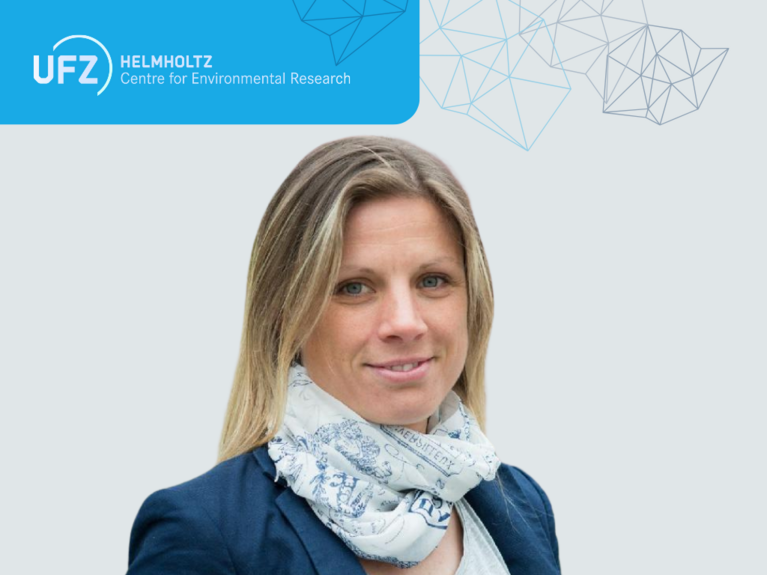Women in AI 2025: meet with Jana Schor, Group Leader at UFZ and Helmholtz AI Associate

To join this international month's celebration of Women in AI - a global initiative to highlight women’s contributions to artificial intelligence - we are putting the spotlight on one of our Helmholtz AI Associates who are driving innovation in AI across diverse research fields.
Today, we have the pleasure of introducing Prof. Dr. Jana Schor. She leads the Bio-Data Science group at the Helmholtz Centre for Environmental Research (UFZ), where her work focuses on developing and applying artificial intelligence methods to understand and mitigate chemical pollution and biodiversity loss and to make environmental knowledge more accessible and actionable.
What is your current research focused on? What are some key topics you explore in your work and what is their impact?
My research lies at the intersection of computer science and environmental science, with a particular focus on chemical pollution and biodiversity loss—two critical facets of the ongoing triple planetary crisis. A significant part of my work involves developing AI-based methods to predict how chemicals interact with biological systems. For example, we have developed a deep learning framework to estimate the bioactivity of environmental pollutants on hormone receptors, supporting regulatory decision-making in chemical risk assessment and reducing the number of animal experiments required.
Another key topic is the democratization of knowledge through large language models. We’ve developed a Retrieval-Augmented Generation (RAG)-based chat agent that integrates domain-specific knowledge to make complex toxicological and ecological data accessible, even for those without programming or AI expertise. This is essential in an increasingly data-driven field, where many stakeholders—regulators, ecologists, public health experts—need to make informed decisions without being specialists in machine learning.
Ultimately, my goal is to advance interpretable, scalable AI solutions that support both scientific discovery and evidence-based environmental policy. The impact is twofold: it improves our predictive understanding of chemical hazards and makes scientific knowledge more inclusive through digital tools.
What inspired you to pursue a career in science, and specifically AI? Was there a key moment, person, or experience that motivated you?
I wouldn’t describe my career as something I pursued with a clear blueprint from the start — it evolved, step by step, driven more by curiosity and the desire to solve real problems than by any specific plan. I’ve always been drawn to complex systems and the challenge of making sense of messy, heterogeneous data, particularly in the context of environmental and public health risks.
My interest in AI came naturally as the scale and complexity of the data we work with grew. Traditional methods were no longer sufficient, and AI offered new ways to model biological interactions, integrate fragmented knowledge, and identify patterns that would otherwise remain hidden. It wasn’t a single defining moment but rather a gradual realization: if we want to understand and mitigate the impact of chemicals on ecosystems and human health, we need tools that can address uncertainty, scale, and interdisciplinarity. AI is exactly that kind of tool.
What advice would you give to young girls and women, hesitant to pursue work and studies in AI?
AI is not an exclusive club. You don’t need to fit a certain mold or have a predefined background to engage with it meaningfully. If you’re interested in patterns, systems, or solving real-world problems, AI can be a handy tool—regardless of whether you see yourself as a “tech person.”
It’s essential to distinguish the field itself from the surrounding noise. There’s often a lot of hype, but underneath that, AI is about methods and applications that anyone can learn and use. Start small, stay curious, and don’t be discouraged by the image the field sometimes projects. You don’t need to be perfect, or a genius, or loud about your work to make a real impact.
How did you learn about Helmholtz AI? Is Helmholtz AI influencing your work in any way? We had the pleasure to welcome you at HAICON earlier this year, what are your impressions?
I first came across Helmholtz AI during the Helmholtz Data Science Incubator initiative, which laid the groundwork for cross-center collaboration in data-driven research. Building on that momentum, I submitted a project proposal to the Helmholtz AI annual call and received funding in 2020. Since then, I’ve been part of and very fond of this dynamic and growing community.
Helmholtz AI has played a significant role in shaping the direction of my work. It has provided not only funding but also a space for methodologically driven dialogue—something that’s often missing in applied research domains. Through this network, we’ve had the opportunity to explore expertise and initiatives that are beyond the scope of our research institutions (the UFZ).
I attended HAICON in June, and it was an excellent event. The discussions were not only technically rich but also refreshingly interdisciplinary. It’s encouraging to see how AI is being applied in diverse scientific fields, and even more so to witness the openness to share challenges and build solutions together.
Any final words?
AI is not a revolution in itself—it’s a tool to understand better and navigate the complexities of our world. What matters most is asking the right questions and being willing to collaborate across disciplines to find meaningful answers.